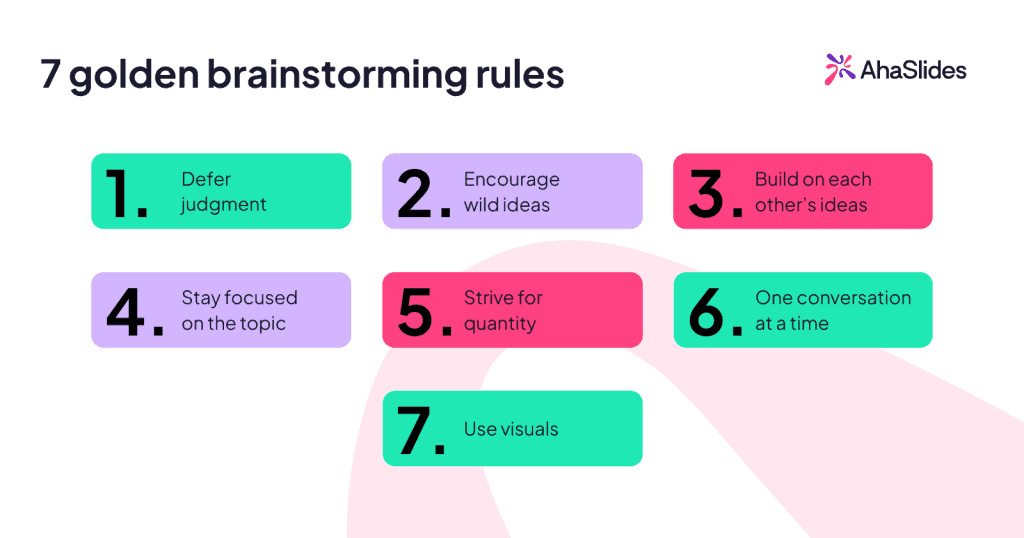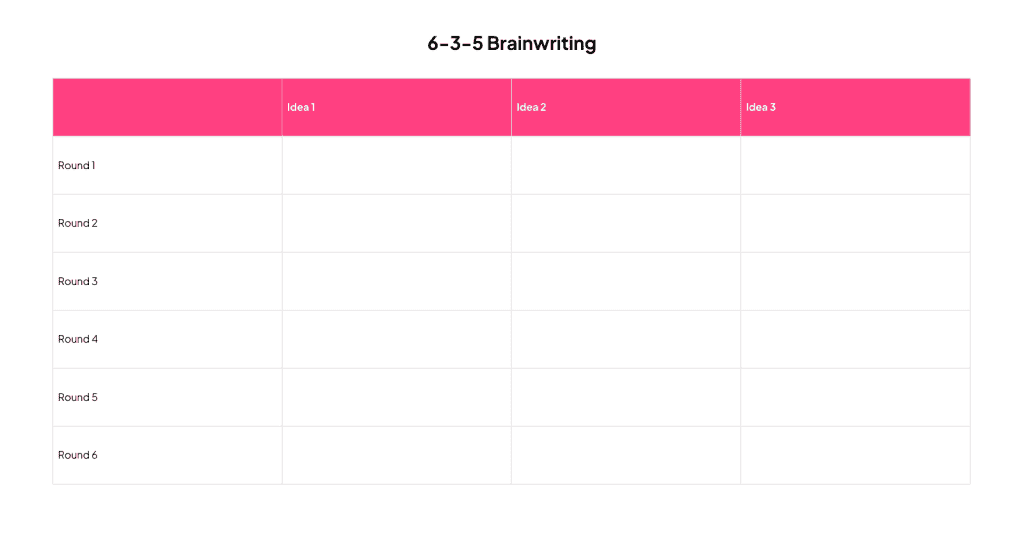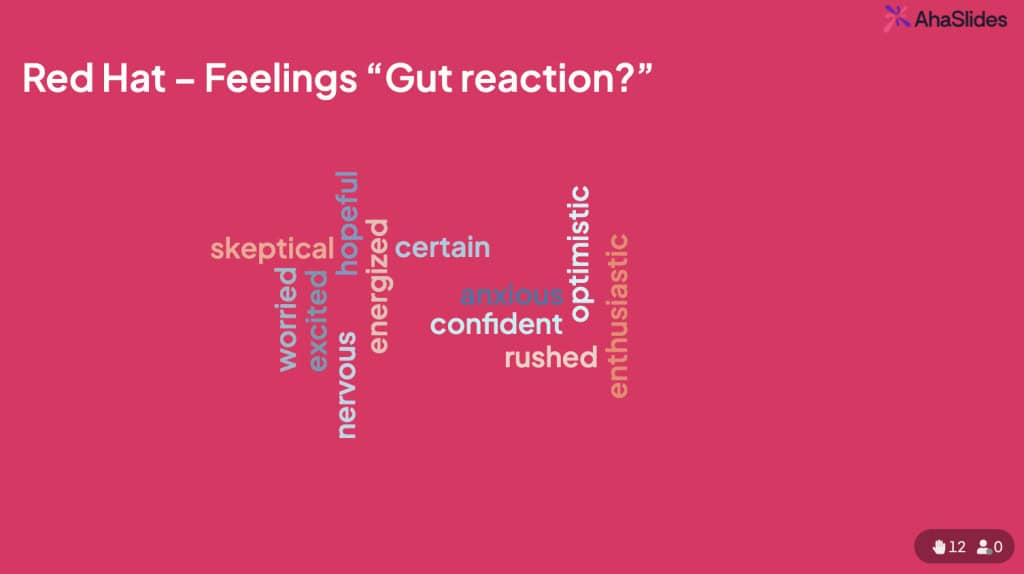Research shows that teams using structured brainstorming methods generate up to 50% more creative solutions than unstructured approaches. This guide synthesizes decades of innovation research and practical experience into one actionable resource that will help your team to brainstorm ideas effectively.
Table of Contents
What is Brainstorming?
Brainstorming is a structured creative process for generating multiple ideas or solutions to a specific problem. First introduced by advertising executive Alex Osborn in 1948, brainstorming encourages free thinking, suspends judgment during idea generation, and creates an environment where unconventional ideas can emerge.
Osborn developed brainstorming while leading BBDO (Batten, Barton, Durstine & Osborn), one of America's largest advertising agencies, during a period when the company was struggling. He noticed that traditional business meetings stifled creativity, with employees holding back ideas for fear of immediate criticism. His solution became what we now know as brainstorming, originally called "thinking up."

When to Use Brainstorming
Brainstorming works best for:
Business applications:
- Product development and innovation
- Marketing campaign ideation
- Problem-solving workshops
- Strategic planning sessions
- Process improvement initiatives
- Customer experience enhancement
Educational settings:
- Pre-writing for essays and kicking off Project-Based Learning (PBL)
- Collaborative learning activities
- Creative writing exercises
- Science fair projects
- Group presentations
- Lesson plan development
Personal projects:
- Event planning
- Creative endeavors (art, writing, music)
- Career development decisions
- Personal goal setting
When NOT to Use Brainstorming
Brainstorming isn't always the answer. Skip brainstorming when:
- Decisions require deep technical expertise from a single domain
- Time constraints are too severe (< 15 minutes available)
- The problem has a single, known correct answer
- Individual reflection would be more productive
- Team dynamics are severely dysfunctional
The Science Behind Effective Brainstorming
Understanding the psychology and research behind brainstorming helps you avoid common pitfalls and structure more effective sessions.
What Research Tells Us
Production blocking
Research by Michael Diehl and Wolfgang Stroebe (1987) identified "production blocking" as a major challenge in group brainstorming. When one person speaks, others must wait, causing them to forget their ideas or lose momentum. This research led to the development of techniques like brainwriting, where everyone contributes simultaneously.
Psychological safety
Amy Edmondson's research at Harvard shows that psychological safety—the belief that you won't be punished or humiliated for speaking up—is the single most important factor in team effectiveness. Teams with high psychological safety generate more creative ideas and take more calculated risks.
A study from Harvard Business Review found that teams who shared embarrassing stories before brainstorming generated 26% more ideas spanning 15% more categories than control groups. The vulnerability created an atmosphere where judgment was suspended, leading to greater creative output.
Cognitive diversity
Research from MIT's Center for Collective Intelligence found that teams with diverse thinking styles and backgrounds consistently outperform homogeneous groups in creative problem-solving. The key isn't just demographic diversity, but cognitive diversity in how team members approach problems.
The anchoring effect
Early ideas in brainstorming sessions tend to anchor subsequent ideas, limiting creative range. Techniques like mind mapping and SCAMPER specifically combat this by forcing participants to explore multiple directions from the start.
Common Brainstorming Pitfalls
Groupthink
The tendency for groups to seek consensus at the expense of critical evaluation. Combat this by encouraging devil's advocates and explicitly welcoming dissenting opinions.
Social loafing
When individuals contribute less in groups than they would alone. Address this through individual accountability, such as having everyone submit ideas before group discussion.
Evaluation apprehension
Fear of negative evaluation causes people to self-censor creative ideas. Anonymous submission tools like AhaSlides solve this by removing attribution during idea generation.

The 7 Essential Brainstorming Rules
These core principles, refined from Alex Osborn's original framework and validated by decades of practice at IDEO, d.school, and leading organizations worldwide, form the foundation of effective brainstorming.

Rule 1: Defer Judgment
What it means: Postpone all criticism and evaluation during idea generation. No idea should be dismissed, critiqued, or evaluated until after the brainstorming session concludes.
Why it matters: Judgment kills creativity before it can flourish. When participants fear criticism, they self-censor and withhold potentially breakthrough ideas. The best innovations often sound ridiculous initially.
How to implement:
- State this rule clearly at the session's start
- Gently redirect any evaluative comments to later discussion
- Model non-judgment as the facilitator
- Consider banning phrases like "That won't work because..." or "We tried that before"
- Use a "parking lot" for ideas requiring immediate discussion
Rule 2: Encourage Wild Ideas
What it means: Actively welcome unconventional, seemingly impractical, or "out-of-the-box" ideas without immediate concern for feasibility.
Why it matters: Wild ideas often contain the seeds of breakthrough solutions. Even impractical ideas can inspire practical innovations when refined. Encouraging wild thinking pushes the group beyond obvious solutions.
How to implement:
- Explicitly invite "impossible" or "crazy" ideas
- Celebrate the most unconventional suggestions
- Ask prompting questions like "What if money were no object?" or "What would we do if we could break any rule?"
- Reserve one section of your brainstorm specifically for "wild card" ideas
Rule 3: Build on Each Other's Ideas
What it means: Listen to others' contributions and expand, combine, or modify them to create new possibilities.
Why it matters: Collaboration multiplies creativity. One person's incomplete thought becomes another's breakthrough solution. Building on ideas creates synergy where the whole exceeds the sum of parts.
How to implement:
- Display all ideas visibly so everyone can reference them
- Ask "How can we build on this?" regularly
- Use "Yes, and..." instead of "Yes, but..."
- Encourage participants to combine multiple ideas
- Give credit to both original contributors and those who build on ideas
Rule 4: Stay Focused on the Topic
What it means: Ensure ideas remain relevant to the specific problem or challenge being addressed, while still allowing creative exploration within that boundary.
Why it matters: Focus prevents wasted time and ensures productive sessions. While creativity is encouraged, maintaining relevance ensures ideas can actually address the challenge at hand.
How to implement:
- Write the problem or question prominently where everyone can see it
- Gently redirect when ideas drift too far off-topic
- Use a "parking lot" for interesting but tangential ideas
- Periodically restate the core challenge
- Balance focus with flexibility
Rule 5: Strive for Quantity
What it means: Generate as many ideas as possible without worrying about quality or feasibility during the initial phase.
Why it matters: Research consistently shows that quantity leads to quality. The first ideas are usually obvious. Breakthrough solutions typically emerge after exhausting conventional thinking. More options provide better chances of finding exceptional solutions.
How to implement:
- Set specific quantity goals (e.g., "50 ideas in 20 minutes")
- Use timers to create urgency
- Encourage rapid-fire idea generation
- Remind participants that every idea counts
- Track idea count visibly to build momentum
Rule 6: One Conversation at a Time
What it means: Maintain focus by having only one person speak at a time, ensuring everyone can hear and consider each idea.
Why it matters: Side conversations create noise that drowns out good ideas. When people multi-task between listening and talking, they miss opportunities to build on others' contributions.
How to implement:
- Establish clear turn-taking protocols
- Use round-robin or raised-hand systems
- In virtual sessions, use chat for side notes and verbal for main ideas
- Keep side conversations to breaks
- Redirect gently when multiple conversations emerge
Rule 7: Use Visuals
What it means: Leverage visual communication, sketches, diagrams, and imagery to express and develop ideas more effectively than words alone.
Why it matters: Visual thinking engages different parts of the brain, triggering new connections and ideas. Simple visuals communicate complex concepts faster than text. Even stick figures beat no visuals.
How to implement:
- Provide markers, sticky notes, and large paper or whiteboards
- Encourage sketching, even for those who "can't draw"
- Use visual frameworks (mind maps, matrices, diagrams)
- Capture ideas with both words and images
- Leverage digital tools like AhaSlides' live word clouds generator to visualize emerging themes
How to Prepare for a Brainstorming Session
Successful brainstorming starts before participants enter the room. Proper preparation dramatically improves session quality and outcomes.
Step 1: Define the Problem Clearly
The quality of your brainstorming outcomes depends heavily on how well you frame the problem. Invest time in crafting a clear, specific problem statement.
Best practices for problem framing:
Be specific, not vague:
- Instead of: "How do we increase sales?"
- Try: "How do we increase online sales to millennials in urban areas by 20% in Q2?"
Focus on outcomes, not solutions:
- Instead of: "Should we create a mobile app?"
- Try: "How do we make our service more accessible to customers on-the-go?"
Use "How might we" questions: This design thinking framework opens possibilities while maintaining focus.
- "How might we reduce customer service wait times?"
- "How might we make learning more engaging for 5th graders?"
- "How might we help new employees feel connected to company culture?"
Consider user stories: Frame challenges from the user's perspective:
- "As a [user type], I want [goal], because [reason]"
- "As a busy parent, I want quick healthy meal options, because I have limited time after work"
Step 2: Select the Right Participants
Optimal group size: 5-12 people
Too few limits perspectives; too many creates production blocking and coordination challenges.
Diversity matters:
- Cognitive diversity: Include different thinking styles and problem-solving approaches
- Domain diversity: Mix subject matter experts with "outside" perspectives
- Hierarchical diversity: Include various organizational levels (but manage power dynamics carefully)
- Demographic diversity: Different backgrounds bring different insights
Who to include:
- People directly impacted by the problem
- Subject matter experts with relevant knowledge
- Creative thinkers who challenge assumptions
- Implementation stakeholders who'll execute solutions
- "Outsiders" with fresh perspectives
Who to exclude (or invite selectively):
- Extreme skeptics who consistently shoot down ideas
- Those with power to shut down ideas prematurely
- People tangential to the problem who'll derail focus
Step 3: Choose the Right Environment
Physical environment (in-person):
- Large open space with moveable furniture
- Abundant wall space for posting ideas
- Good lighting and comfortable temperature
- Minimal distractions and interruptions
- Access to materials (sticky notes, markers, whiteboards)
Virtual environment:
- Reliable video conferencing platform
- Digital whiteboard or collaboration tool (Miro, Mural, AhaSlides)
- Backup communication method
- Pre-session tech check
- Clear virtual ground rules
Timing considerations:
- Avoid early Monday mornings or late Friday afternoons
- Schedule around participants' peak energy times
- Allow adequate time (typically 60-90 minutes for complex problems)
- Build in breaks for longer sessions
Step 4: Set the Agenda
A clear agenda keeps sessions productive and focused.
Sample 90-minute brainstorming agenda:
0:00-0:10 - Welcome and warm-up
- Introductions if needed
- Review ground rules
- Quick icebreaker activity
0:10-0:20 - Problem framing
- Present the challenge clearly
- Provide context and background
- Answer clarifying questions
- Share any relevant data or constraints
0:20-0:50 - Divergent thinking (idea generation)
- Use chosen brainstorming technique(s)
- Encourage quantity
- Suspend judgment
- Capture all ideas
0:50-1:00 - Break
- Brief reset
- Informal processing time
1:00-1:20 - Convergent thinking (refinement)
- Organize ideas into themes
- Combine similar concepts
- Initial evaluation against criteria
1:20-1:30 - Next steps
- Identify top ideas for further development
- Assign follow-up responsibilities
- Schedule any needed additional sessions
- Thank participants
Step 5: Prepare Materials and Tools
Physical materials:
- Sticky notes (multiple colors)
- Markers and pens
- Large paper or flipcharts
- Whiteboard
- Dots or stickers for voting
- Timer
- Camera to document results
Digital tools:
- AhaSlides for interactive brainstorming, word clouds, and voting
- Digital whiteboard (Miro, Mural, Conceptboard)
- Mind mapping software
- Document for capturing ideas
- Screen sharing capability
Step 6: Send Pre-Work (Optional)
For complex challenges, consider sending participants:
- Background on the problem
- Relevant data or research
- Questions to consider in advance
- Request to come with 3-5 initial ideas
- Agenda and logistics
Note: Balance pre-work against spontaneity. Sometimes the freshest ideas come from minimal preparation.
20+ Proven Brainstorming Techniques
Different techniques suit different situations, group sizes, and objectives. Master these methods and you'll have a tool for every brainstorming scenario.
Visual Techniques
These methods leverage visual thinking to unlock creativity and organize complex ideas.
1. Mind Mapping
What it is: A visual technique that organizes ideas around a central concept, using branches to show relationships and connections.
When to use:
- Exploring complex topics with multiple dimensions
- Planning projects or content
- Organizing information that has natural hierarchies
- Working with visual thinkers
How it works:
- Write the central topic in the middle of a large page
- Draw branches for major themes or categories
- Add sub-branches for related ideas
- Continue branching to explore details
- Use colors, images, and symbols to enhance meaning
- Draw connections between different branches
Pros:
- Mirrors natural thought processes
- Shows relationships between ideas
- Encourages non-linear thinking
- Easy to add details progressively
Cons:
- Can become complex and overwhelming
- Less effective for simple, linear problems
- Requires space and visual materials
Example: A marketing team mind-mapping a product launch might have branches for target audiences, channels, messaging, timing, and budget, with each branch expanding into specific tactics and considerations.

2. Storyboarding
What it is: A sequential visual narrative that maps out a process, experience, or journey using sketches or descriptions.
When to use:
- Designing user experiences or customer journeys
- Planning events or processes
- Developing training materials
- Creating narrative-driven content
How it works:
- Identify the starting point and desired end state
- Break the journey into key stages or moments
- Create a frame for each stage
- Sketch or describe what happens in each frame
- Show connections and transitions between frames
- Add notes about emotions, pain points, or opportunities
Pros:
- Visualizes processes and experiences
- Identifies gaps and pain points
- Creates shared understanding of sequences
- Works for both physical and digital experiences
Cons:
- Time-intensive to create detailed storyboards
- Requires some comfort with visual expression
- Can overemphasize linear progression
Example: An onboarding team storyboarding a new employee's first week, with frames showing pre-arrival preparation, arrival, team introductions, initial training, first project assignment, and week-end check-in.

3. Sketchstorming
What it is: Rapid visual idea generation where participants sketch concepts quickly, even with limited drawing skills.
When to use:
- Product design and development
- User interface ideation
- Visual branding exercises
- Any project benefiting from visual exploration
How it works:
- Set a time limit (typically 5-10 minutes)
- Each participant sketches their ideas
- No artistic skill required—stick figures and simple shapes work
- Share and build on each other's sketches
- Combine strongest visual elements
Pros:
- Breaks free from text-based thinking
- Accessible to everyone (no artistic skill needed)
- Communicates complex ideas quickly
- Engages different cognitive processes
Cons:
- Some people resist due to drawing anxiety
- Can emphasize form over function
- May disadvantage those with visual impairments
4. Crazy Eights
What it is: A rapid sketching technique where participants generate eight different ideas in eight minutes, spending one minute per sketch.
When to use:
- Pushing beyond obvious first ideas
- Time-constrained ideation
- Generating visual variety quickly
- Individual or small group sessions
How it works:
- Fold a sheet of paper into eight sections
- Set a timer for 8 minutes
- Sketch one idea per section, spending roughly 1 minute each
- Share sketches when time expires
- Discuss, combine, and refine top ideas
Pros:
- Forces quick thinking and prevents overthinking
- Generates volume rapidly
- Equal participation (everyone creates 8 ideas)
- Uncovers diverse approaches
Cons:
- Can feel rushed and stressful
- Quality may suffer due to time pressure
- Not suitable for complex problems requiring deep thought

Quiet Techniques
These approaches give introverts and deliberate thinkers space to contribute meaningfully, reducing the dominance of extroverted voices.
5. Brainwriting
What it is: Silent, individual idea generation where participants write ideas before sharing with the group.
When to use:
- Groups with dominant personalities
- Introverted team members
- Reducing social pressure and groupthink
- Ensuring equal contribution
- Virtual or asynchronous brainstorming
How it works:
- Give each participant paper or digital document
- Pose the problem clearly
- Set time limit (5-10 minutes)
- Participants write ideas silently
- Collect and share ideas (anonymously if desired)
- Discuss and build on ideas as a group
Pros:
- Equal participation regardless of personality
- Reduces social anxiety and judgment
- Prevents dominant voices from taking over
- Allows time for deeper reflection
- Works well remotely
Cons:
- Less energy than verbal brainstorming
- Loses some spontaneous building on ideas
- May feel disconnected or isolating
Example: A product team exploring new feature ideas. Each person spends 10 minutes listing features, then all ideas are shared anonymously via AhaSlides. The team votes on top concepts, then discusses implementation.
6. 6-3-5 Brainwriting
What it is: A structured brainwriting method where 6 people write 3 ideas in 5 minutes, then pass their paper to the next person who adds to or modifies those ideas.
When to use:
- Building on each other's ideas systematically
- Generating large volumes quickly (108 ideas in 30 minutes)
- Ensuring everyone contributes equally
- Combining quiet reflection with collaboration
How it works:
- Gather 6 participants (adaptable to other numbers)
- Each person writes 3 ideas in 5 minutes
- Pass papers to the right
- Read the existing ideas and add 3 more (building on, modifying, or adding new)
- Repeat 5 more rounds (6 total)
- Review and discuss all ideas
Pros:
- Generates high volume systematically (6 people × 3 ideas × 6 rounds = 108 ideas)
- Builds on ideas progressively
- Equal participation guaranteed
- Combines individual and group thinking
Cons:
- Rigid structure may feel constraining
- Requires specific group size
- Ideas may become repetitive in later rounds
- Time-intensive for full process

7. Nominal Group Technique (NGT)
What it is: A structured method combining silent idea generation, sharing, discussion, and democratic voting to prioritize ideas.
When to use:
- Important decisions requiring consensus
- Groups with power imbalances
- Prioritizing from many options
- Ensuring fair participation
- Controversial or sensitive topics
How it works:
- Silent generation: Participants write ideas individually (5-10 minutes)
- Round-robin sharing: Each person shares one idea; facilitator records all ideas without discussion
- Clarification: Group discusses ideas for understanding (not evaluation)
- Individual ranking: Each person privately ranks or votes on ideas
- Group prioritization: Combine individual rankings to identify top priorities
- Discussion: Discuss top-ranked ideas and make decisions
Pros:
- Balances individual and group input
- Reduces influence of dominant personalities
- Creates buy-in through participation
- Democratic and transparent process
- Works well for controversial topics
Cons:
- More time-intensive than simple brainstorming
- Formal structure may feel rigid
- Can suppress spontaneous discussion
- Voting may oversimplify complex issues
Analytical Techniques
These methods provide structure for systematic analysis, helping teams evaluate ideas from multiple angles.
8. SWOT Analysis
What it is: A framework evaluating Strengths, Weaknesses, Opportunities, and Threats for ideas, strategies, or decisions.
When to use:
- Strategic planning and decision-making
- Evaluating multiple options
- Assessing feasibility before implementation
- Risk identification
- Business planning
How it works:
- Define the idea, project, or strategy to analyze
- Create four quadrants: Strengths, Weaknesses, Opportunities, Threats
- Brainstorm items for each quadrant:
- Strengths: Internal positive factors and advantages
- Weaknesses: Internal negative factors and limitations
- Opportunities: External positive factors and possibilities
- Threats: External negative factors and risks
- Discuss and prioritize items in each quadrant
- Develop strategies based on the analysis
Pros:
- Comprehensive view of situation
- Considers both internal and external factors
- Identifies risks early
- Creates shared understanding
- Supports data-driven decisions
Cons:
- Can be superficial if rushed
- May oversimplify complex situations
- Requires honest assessment
- Static snapshot (doesn't show evolution)
9. Six Thinking Hats
What it is: A technique by Edward de Bono that explores problems from six distinct perspectives, represented by colored "hats."
When to use:
- Complex decisions requiring thorough analysis
- Reducing argument and conflict
- Ensuring multiple perspectives are considered
- Breaking out of habitual thinking patterns
The Six Hats:
- White Hat: Facts and data (objective information)
- Red Hat: Emotions and feelings (intuitive responses)
- Black Hat: Critical thinking (risks, problems, why it might not work)
- Yellow Hat: Optimism and benefits (why it will work, advantages)
- Green Hat: Creativity (new ideas, alternatives, possibilities)
- Blue Hat: Process control (facilitation, organization, next steps)
How it works:
- Introduce the six thinking perspectives
- Everyone "wears" the same hat simultaneously
- Explore the problem from that perspective
- Switch hats systematically (usually 5-10 minutes per hat)
- Blue Hat facilitates and determines sequence
- Synthesize insights from all perspectives
Pros:
- Separates different types of thinking
- Reduces argument (everyone explores same perspective together)
- Ensures comprehensive analysis
- Legitimizes emotional and creative thinking
- Creates psychological separation from personal views
Cons:
- Requires training and practice
- Can feel artificial initially
- Time-intensive for full process
- May oversimplify complex emotional responses

10. Starbursting
What it is: An idea evaluation method that generates questions about an idea using the "who, what, when, where, why, and how" framework.
When to use:
- Vetting ideas thoroughly before implementation
- Identifying gaps and assumptions
- Planning and preparation
- Uncovering potential challenges
How it works:
- Draw a six-pointed star with your idea in the center
- Label each point with: Who, What, When, Where, Why, How
- Generate questions for each point:
- Who: Who will benefit? Who will implement? Who might resist?
- What: What resources are needed? What are the steps? What could go wrong?
- When: When should this launch? When will we see results?
- Where: Where will this happen? Where might challenges arise?
- Why: Why is this important? Why might it fail?
- How: How will we execute? How will we measure success?
- Discuss answers and implications
- Identify areas requiring more information or planning
Pros:
- Systematic and thorough
- Uncovers assumptions and gaps
- Generates implementation insights
- Easy to understand and use
- Applicable to any idea or project
Cons:
- Primarily analytical (not idea generation)
- Can generate too many questions
- May create analysis paralysis
- Less creative than other techniques
11. Reverse Brainstorming
What it is: Generating ideas for how to cause or worsen a problem, then reversing those ideas to find solutions.
When to use:
- Stuck on a difficult problem
- Breaking through conventional thinking
- Identifying root causes
- Challenging assumptions
- Making problem-solving fun and engaging
How it works:
- Clearly state the problem you want to solve
- Reverse it: "How can we make this problem worse?" or "How can we guarantee failure?"
- Generate as many ideas as possible for causing the problem
- Reverse each idea to identify potential solutions
- Evaluate and refine the reversed solutions
- Develop implementation plans for promising ideas
Example:
- Original problem: How do we improve customer satisfaction?
- Reversed: How do we make customers angry and frustrated?
- Reversed ideas: Ignore their calls, be rude, ship wrong products, provide no information
- Solutions: Improve response times, train staff in customer service, implement quality control, create comprehensive FAQs
Pros:
- Makes problem-solving fun and energizing
- Reveals hidden assumptions
- Easier to criticize than create (taps into that energy)
- Identifies root causes
- Engages skeptical participants
Cons:
- Indirect route to solutions
- May generate unrealistic "reverse" ideas
- Requires translation step (reverse to solution)
- Can become negative if not managed well

12. Five Whys
What it is: A root cause analysis technique that asks "why" repeatedly (typically five times) to dig beneath surface symptoms and find underlying issues.
When to use:
- Problem diagnosis and root cause analysis
- Understanding failures or issues
- Moving beyond symptoms to causes
- Simple problems with clear cause-effect chains
How it works:
- State the problem clearly
- Ask "Why does this happen?"
- Answer based on facts
- Ask "Why?" about that answer
- Continue asking "Why?" (usually 5 times, but may be more or fewer)
- When you reach a root cause (cannot meaningfully ask why again), develop solutions targeting that cause
Example:
- Problem: We missed our project deadline
- Why? The final report wasn't ready
- Why? Key data wasn't available
- Why? The survey wasn't sent to customers
- Why? We didn't have an updated customer list
- Why? We don't have a process for maintaining customer data
- Root cause: Lack of customer data management process
- Solution: Implement CRM system with data maintenance protocols
Pros:
- Simple and accessible
- Digs beneath surface symptoms
- Identifies actionable root causes
- Works for many types of problems
- Encourages critical thinking
Cons:
- Oversimplifies complex problems with multiple causes
- Assumes linear cause-effect relationships
- Investigator bias can lead to predetermined "root causes"
- May miss systemic or cultural factors
Collaborative Techniques
These methods leverage group dynamics and build on collective intelligence.
13. Round-Robin Brainstorming
What it is: A structured approach where participants take turns sharing one idea at a time, ensuring everyone contributes equally.
When to use:
- Ensuring equal participation
- Groups with dominant personalities
- Generating comprehensive lists
- In-person or virtual meetings
How it works:
- Sit in a circle (physical or virtual)
- Set ground rules (one idea per turn, pass if needed)
- Start with one person sharing an idea
- Move clockwise, each person sharing one idea
- Continue rounds until ideas are exhausted
- Allow "passes" when someone has no new ideas
- Capture all ideas visibly
Pros:
- Guarantees everyone speaks
- Prevents domination by few voices
- Structured and predictable
- Easy to facilitate
- Builds on previous ideas
Cons:
- Can feel slow or rigid
- Pressure to contribute in turn
- May lose spontaneous connections
- People may spend turns thinking instead of listening
14. Rapid Ideation
What it is: Fast-paced, high-energy idea generation with strict time limits to prevent overthinking and maximize quantity.
When to use:
- Breaking through analysis paralysis
- Generating large volumes quickly
- Energizing a group
- Pushing beyond obvious ideas
How it works:
- Set aggressive time limit (typically 5-15 minutes)
- Aim for specific quantity goal
- Generate ideas as fast as possible
- No discussion or evaluation during generation
- Capture everything, no matter how rough
- Review and refine after time expires
Pros:
- High energy and engaging
- Prevents overthinking
- Generates volume rapidly
- Breaks through perfectionism
- Creates momentum
Cons:
- Quality may suffer
- Can be stressful
- May favor quick thinkers over deep thinkers
- Difficult to capture ideas fast enough
15. Affinity Mapping
What it is: Organizing large numbers of ideas into related groups to identify patterns, themes, and priorities.
When to use:
- After generating many ideas
- Synthesizing complex information
- Identifying themes and patterns
- Building consensus around categories
How it works:
- Generate ideas (using any technique)
- Write each idea on separate sticky note
- Display all ideas visibly
- Silently group related ideas together
- Create category labels for each group
- Discuss and refine groupings
- Prioritize categories or ideas within categories
Pros:
- Makes sense of large idea sets
- Reveals patterns and themes
- Collaborative and democratic
- Visual and tangible
- Builds shared understanding
Cons:
- Not an idea generation technique (organization only)
- Can be time-consuming with many ideas
- Disagreement on categorization
- Some ideas may fit multiple categories

Question-Based Techniques
These approaches use questions rather than answers to unlock new perspectives.
16. Question Bursts
What it is: A technique developed by MIT professor Hal Gregersen where teams generate as many questions as possible in a short time, rather than answers.
When to use:
- Reframing problems
- Challenging assumptions
- Getting unstuck
- Seeing problems from new angles
How it works:
- Present the challenge in 2 minutes (high-level, minimal detail)
- Set timer for 4 minutes
- Generate as many questions as possible (aim for 15+)
- Rules: Questions only, no preambles, no answering questions
- Review questions and identify most provocative ones
- Select top questions to explore further
Pros:
- Reframes problems quickly
- Easier than generating solutions
- Uncovers assumptions
- Creates fresh perspectives
- Engaging and energizing
Cons:
- Doesn't generate solutions directly
- Requires follow-up to answer questions
- Can feel frustrating without answers
- May generate too many directions to pursue
17. How Might We (HMW) Questions
What it is: A design thinking method that frames problems as opportunities using the "How might we..." structure.
When to use:
- Defining design challenges
- Reframing negative problems as positive opportunities
- Beginning ideation sessions
- Creating optimistic, actionable problem statements
How it works:
- Start with a problem or insight
- Reframe as "How might we..." question
- Make it:
- Optimistic (assumes solutions exist)
- Open (allows multiple solutions)
- Actionable (suggests clear direction)
- Not too broad or too narrow
- Generate multiple HMW variations
- Select most promising HMW to brainstorm solutions
Pros:
- Creates optimistic, opportunity-focused framing
- Opens multiple solution paths
- Widely used in design thinking
- Easy to learn and apply
- Shifts mindset from problem to possibility
Cons:
- Doesn't generate solutions (just frames questions)
- Can feel formulaic
- Risk of questions that are too broad or vague
- May oversimplify complex problems

Advanced Techniques
18. SCAMPER
What it is: An acronym-based checklist that prompts creative thinking by systematically modifying existing ideas.
The SCAMPER Prompts:
- Substitute: What can be replaced or swapped?
- Combine: What can be merged or integrated?
- Adapt: What can be adjusted for different use?
- Modify/Magnify/Minify: What can be changed in scale or attributes?
- Put to another use: How else could this be used?
- Eliminate: What can be removed or simplified?
- Reverse/Rearrange: What can be done backwards or in different order?
When to use:
- Product development and innovation
- Improving existing solutions
- When stuck on a problem
- Systematic creativity exercises
How it works:
- Select an existing product, process, or idea
- Apply each SCAMPER prompt systematically
- Generate ideas for each category
- Combine promising modifications
- Evaluate feasibility and impact
Pros:
- Systematic and comprehensive
- Works for any existing idea or product
- Easy to remember (acronym)
- Forces exploration of multiple directions
- Good for innovation workshops
Cons:
- Builds on existing ideas (not for truly new concepts)
- Can feel mechanical
- Generates many mediocre ideas
- Requires strong existing idea to start
Choosing the Right Technique
With 20+ techniques available, how do you choose? Consider:
Group size:
- Small groups (2-5): Question bursts, rapid ideation, SCAMPER
- Medium groups (6-12): Brainwriting, round-robin, Six Thinking Hats
- Large groups (13+): Affinity mapping, nominal group technique
Session goals:
- Maximum quantity: Rapid ideation, crazy eights, round-robin
- Deep exploration: SWOT, Six Thinking Hats, Five Whys
- Equal participation: Brainwriting, nominal group technique
- Visual thinking: Mind mapping, storyboarding, sketchstorming
- Problem diagnosis: Five Whys, reverse brainstorming
Team dynamics:
- Dominant personalities: Brainwriting, nominal group technique
- Introverted team: Quiet techniques
- Skeptical team: Reverse brainstorming, Six Thinking Hats
- Need fresh perspectives: Question bursts, SCAMPER
Step-by-Step Brainstorming Process
Follow this proven framework to run effective brainstorming sessions from start to finish.
Phase 1: Warm-Up (5-10 minutes)
Starting cold leads to awkward silence and superficial ideas. Warm up the creative muscles with a quick activity.
Effective icebreakers:
Embarrassing story sharing
You can ask each person to share an embarrassing story related to their work, like 'Share your best "replied all" horror story.' This creates common bridges among participants and let everyone be comfortable with each other in a shorter time span.

Desert island
Ask everyone what 3 items they'd want if stranded on a desert island for one year.
Two Truths and a Lie
Each person shares three statements about themselves—two true, one false. Others guess the lie.
Quick quiz
Run a 5-minute fun quiz using AhaSlides on a lighthearted topic.
Phase 2: Problem Framing (5-15 minutes)
Present the challenge clearly:
- State the problem simply and specifically
- Provide relevant context and background
- Share key constraints (budget, time, resources)
- Explain why solving this matters
- Clarify what success looks like
- Answer clarifying questions
Phase 3: Divergent Thinking - Idea Generation (20-40 minutes)
This is the core brainstorming phase. Use one or more techniques from the previous section.
Key principles:
- Enforce the 7 brainstorming rules strictly
- Encourage volume over quality
- Capture every idea visibly
- Keep energy high
- Prevent evaluation or criticism
- Set clear time limits
Using AhaSlides for idea generation:
- Create a brainstorming slide with your problem statement
- Participants submit ideas from their phones
- Ideas appear live on screen
- Everyone can see the full collection and vote on the best ideas for next phase

Phase 4: Break (5-10 minutes)
Don't skip the break! It allows ideas to incubate, energy to reset, and mental shift from generation to evaluation mode.
Phase 5: Convergent Thinking - Organization & Refinement (15-30 minutes)
Step 1: Organize ideas - Group similar ideas using affinity mapping:
- Silently sort ideas into related themes
- Create category labels
- Discuss groupings and refine
- Identify patterns
Step 2: Clarify ideas
- Review unclear ideas
- Ask proposers to explain
- Combine duplicate or very similar ideas
- Capture intent, not just words
Step 3: Initial evaluation - Apply quick filters:
- Does it address the problem?
- Is it feasible (even if challenging)?
- Is it new/different enough to pursue?
Step 4: Voting on top ideas -Use multi-voting to narrow options:
- Give each person 3-5 votes
- Can place multiple votes on one idea if strongly preferred
- Tally votes
- Discuss top 5-10 ideas
Using AhaSlides for voting:
- Add top ideas to a poll slide
- Participants vote from their phones
- Results display live
- Instantly see top priorities
Phase 6: Next Steps (5-10 minutes)
Don't end without clear action items:
Assign ownership:
- Who will develop each top idea further?
- When will they report back?
- What resources do they need?
Schedule follow-up:
- Set date for next discussion
- Determine what analysis is needed
- Create timeline for decisions
Document everything:
- Capture all ideas
- Save categories and themes
- Record decisions made
- Share summary with all participants
Thank participants
Brainstorming for Different Contexts
Business and Workplace Brainstorming
Common applications:
- Product development and feature ideation
- Marketing campaigns and content strategies
- Process improvement initiatives
- Strategic planning
- Problem-solving workshops
Business-specific considerations:
- Power dynamics: Senior leaders can inhibit honest ideation
- ROI pressure: Balance creative freedom with business constraints
- Cross-functional needs: Include diverse departments
- Implementation focus: End with concrete action plans
Sample business brainstorming questions:
- "What channels should we focus on to maximize revenue growth?"
- "How might we differentiate our product in a crowded market?"
- "What's the ideal customer persona for our new service?"
- "How can we reduce customer acquisition cost by 30%?"
- "What positions should we hire for next and why?"

Educational Brainstorming
Common applications:
- Essay and project planning
- Group assignments and presentations
- Creative writing exercises
- STEM problem-solving
- Classroom discussions
Education-specific considerations:
- Skill development: Use brainstorming to teach critical thinking
- Varying ages: Adapt techniques for developmental levels
- Assessment: Consider how to evaluate participation fairly
- Engagement: Make it fun and interactive
- Quiet students: Use techniques ensuring everyone contributes
Sample educational brainstorming questions:
Elementary (K-5):
- "What's the best way to get to school and why?"
- "If you could invent anything, what would it be?"
- "How can we make our classroom more fun?"
Middle school:
- "How can we reduce waste in our cafeteria?"
- "What are different perspectives on this historical event?"
- "How might we design a better school schedule?"
High school:
- "What's the best way to measure a country's success?"
- "How should we address climate change in our community?"
- "What role should social media play in education?"
College/university:
- "How might we reimagine higher education for the 21st century?"
- "What research questions matter most in our field?"
- "How can we make academic research more accessible?"

Remote and Hybrid Brainstorming
Special challenges:
- Technology barriers and connectivity issues
- Reduced nonverbal communication
- "Zoom fatigue" and shorter attention spans
- Difficulty building energy and momentum
- Time zone coordination
Best practices:
Technology setup:
- Test all tools beforehand
- Have backup communication methods
- Use digital whiteboards (Miro, Mural)
- Leverage AhaSlides for interactive participation
- Record sessions for those who can't attend live
Facilitation adaptations:
- Shorter sessions (45-60 minutes max)
- More frequent breaks (every 20-30 minutes)
- Explicit turn-taking
- Use chat for side thoughts
- More structured techniques
Engagement strategies:
- Keep cameras on when possible
- Use reactions and emojis for quick feedback
- Leverage polls and voting features
- Breakout rooms for small group work
- Asynchronous components for global teams
Solo Brainstorming
When to brainstorm solo:
- Personal projects and decisions
- Pre-work before group sessions
- Writing and creative projects
- When you need deep focus
Effective solo techniques:
- Mind mapping
- Freewriting
- SCAMPER
- Five Whys
- Question bursts
- Walking brainstorm
Solo brainstorming tips:
- Set specific time limits
- Change environments to shift thinking
- Take breaks and let ideas incubate
- Talk out loud to yourself
- Don't self-censor initially
- Review and refine in a separate session
Troubleshooting Common Brainstorming Problems
Problem: Dominant Voices
Signs:
- Same 2-3 people contribute most ideas
- Others remain silent or disengaged
- Ideas build only in one direction
Solutions:
- Use round-robin to ensure equal turns
- Implement brainwriting or nominal group technique
- Set explicit "no interrupting" rule
- Use anonymous submission tools like AhaSlides
- Have facilitator call on quieter participants
- Break into smaller groups
Problem: Silence and Low Participation
Signs:
- Long awkward pauses
- People looking uncomfortable
- Few or no ideas being shared
- Lack of energy in the room
Solutions:
- Start with a more engaging warm-up
- Use private brainstorming first, then share
- Make submission anonymous
- Reduce group size
- Check if the problem is well-understood
- Share example ideas to prime the pump
- Use more structured techniques
Problem: Premature Judgment and Criticism
Signs:
- People saying "That won't work" or "We tried that"
- Ideas being shot down immediately
- Defensive responses from idea-sharers
- Innovation declining as session progresses
Solutions:
- Restate the "defer judgment" rule
- Gently redirect critical comments
- Consider banning phrases like "Yes, but..."
- Model non-judgmental language as facilitator
- Use techniques that separate generation from evaluation
- Separate people from ideas (anonymous submission)
Problem: Getting Stuck or Running Out of Ideas
Signs:
- Ideas slowing to a trickle
- Repetition of similar concepts
- Participants looking mentally exhausted
- Long pauses with no new contributions
Solutions:
- Switch to a different technique
- Take a break and return refreshed
- Ask prompting questions:
- "What would [competitor/expert] do?"
- "What if we had unlimited budget?"
- "What's the craziest idea we could try?"
- Revisit the problem statement (reframe it)
- Use SCAMPER or another systematic technique
- Bring in fresh perspectives
Problem: Time Management Issues
Signs:
- Running significantly over time
- Rushing important phases
- Not reaching refinement or decision stage
- Participants checking watches or phones
Solutions:
- Set clear time limits upfront
- Use visible timer
- Assign a timekeeper
- Stick to the agenda
- Be willing to extend slightly if productive
- Schedule follow-up session if needed
- Use more time-efficient techniques
Problem: Conflict and Disagreements
Signs:
- Tension between participants
- Defensive or aggressive body language
- Arguments about ideas
- Personal attacks (even subtle ones)
Solutions:
- Pause and restate ground rules
- Remind everyone all ideas are valid in this phase
- Separate people from ideas
- Use Blue Hat (Six Thinking Hats) to refocus
- Take a break to cool down
- Private conversation with conflicting parties
- Focus on shared goals and values
Problem: Virtual Session Technical Issues
Signs:
- Connectivity problems
- Audio/video quality issues
- Tool access problems
- Participants dropping off
Solutions:
- Have backup communication method
- Test technology beforehand
- Share clear instructions in advance
- Record session for those with issues
- Have offline participation option
- Keep sessions shorter
- Use simple, reliable tools
- Have technical support person available

